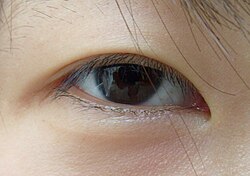| Epicanthic fold | |
|---|---|
 A Korean girl with the skin fold of the upper eyelid covering the inner angle of the eye | |
| Details | |
| Synonyms | Epicanthal fold, epicanthus, eye fold,[2] Mongoloid fold,[3] palpebronasal fold[4] |
| Pronunciation | /ˌɛpɪˌkænθɪk ˈfoʊld/[5] |
| Identifiers | |
| Latin | plica palpebronasalis[1] |
| TA98 | A15.2.07.028 |
| TA2 | 211 |
| FMA | 59370 |
| Anatomical terminology | |
An epicanthic fold or epicanthus[6] is a skin fold of the upper eyelid that covers the inner corner (medial canthus) of the eye.[3] However, variation occurs in the nature of this feature and the possession of "partial epicanthic folds" or "slight epicanthic folds" is noted in the relevant literature.[7][8][9] Various factors influence whether epicanthic folds form, including ancestry, age, and certain medical conditions.
- ^ "AllRefer Health – Epicanthal Folds (Plica Palpebronasalis)". AllRefer.com. Archived from the original on 12 January 2010. Retrieved 1 October 2009.
- ^ "Eye fold".
- ^ a b Das, Ram Narayan (1997). Sterling Dictionary of Anthropology. Sterling. ISBN 9788173590689.
- ^ "Palpebronasal Fold - Medical Dictionary Search". Stedman's Medical Dictionary. 2006. Retrieved 1 October 2009.
- ^ Wells, John (3 April 2008). Longman Pronunciation Dictionary (3rd ed.). Pearson Longman. ISBN 978-1-4058-8118-0.
- ^ "Epicanthus | definition of epicanthus by Medical dictionary". Retrieved 21 July 2020.
- ^ Powell, M. L. (1981) Assessment and management of developmental changes and problems in children, Mosby, Incorporated, p. 38 ISBN 9780801615207
- ^ U. Schilbach, U. and Rott, H-D. (1988) Ocular Hypotelorism, Submucosal Cleft Palate, and Hypospadias: A New Autosomal Dominant Syndrome, American Journal of Medical Genetics 31, pp. 863–870
- ^ Lang, Berel, ed. (2000). Race and Racism in Theory and Practice. Rowman & Littlefield. p. 10. ISBN 9780847696932.